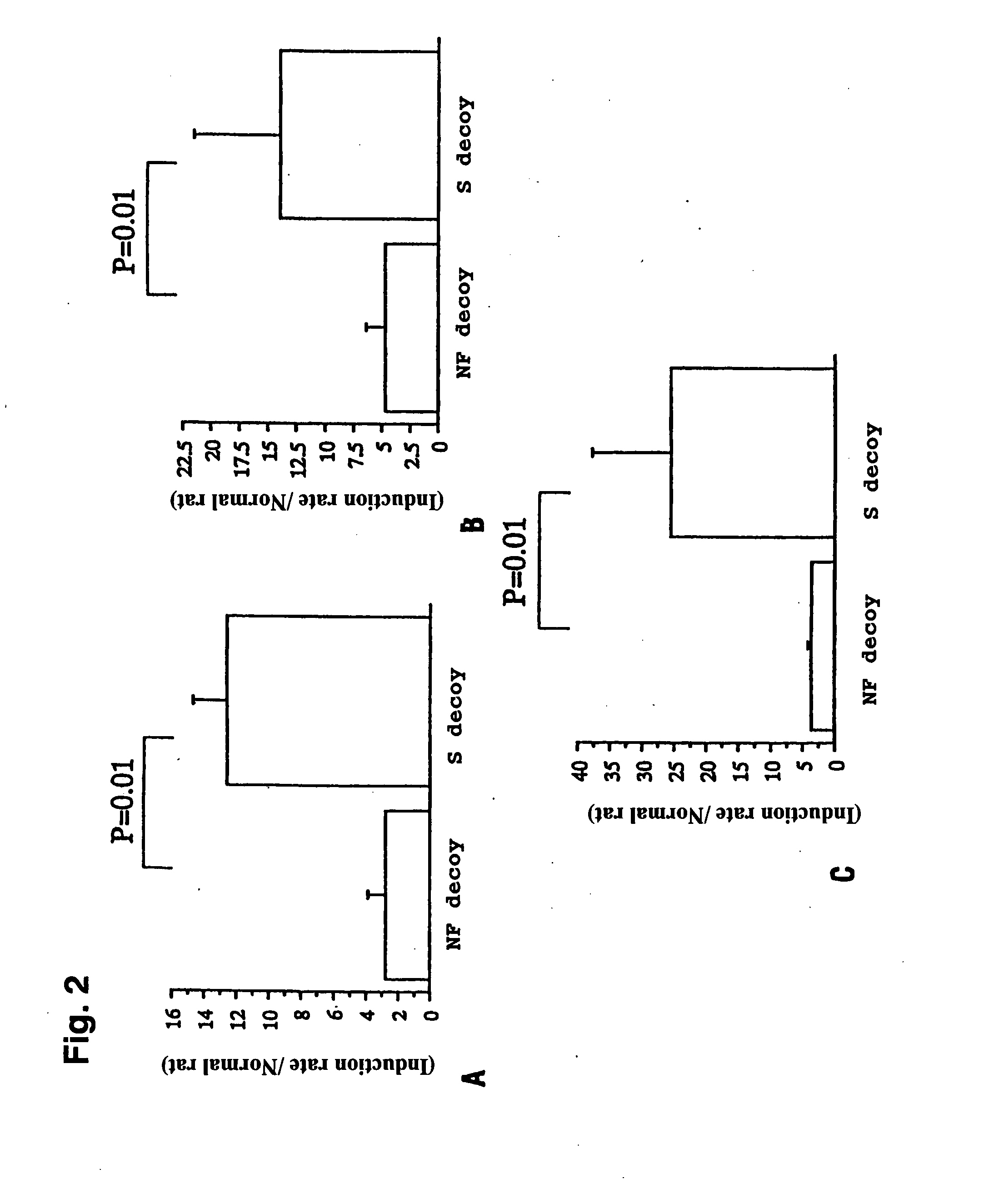Decoy compositions for treating and preventing brain diseases and disorders
a brain disease and composition technology, applied in drug compositions, extracellular fluid disorders, peptide sources, etc., can solve the problems of significant extension of the survival of the recipient animal, difficulty in clinical applications for treatment (therapy and prevention) of various diseases, and higher incidence of neurological sequalae, so as to achieve effective inhibition of expression, and attenuation of neuronal damage
- Summary
- Abstract
- Description
- Claims
- Application Information
AI Technical Summary
Benefits of technology
Problems solved by technology
Method used
Image
Examples
example 1
Preparation of HVJ Virus-Liposome Complex
[0108]A HVJ-liposome complex was prepared as described in references (Morishita R, Sugimoto T, Aoki M, Kida I, Tomita N, Moriguchi A, et al., Nat. Med. 1997; 3:894-9). Briefly, phosphatidylserine (PS), phosphatidylcholine (PC) and cholesterol (Chol) were mixed in a weight ratio of 1:4.8:2. The lipid mixture (10 mg) was deposited on the sides of a flask by removal of a solvent (tetrahydrofuran) in a rotary evaporator. Dried lipid was hydrated in 200 μl of physiological saline containing 200 μg of ODN. Liposomes were prepared by shaking and sonication. Liposome suspension (0.5 mL, containing 10 mg of lipids) was mixed with HVJ (10,000 hemagglutinating units) inactivated in physiological saline having a total volume of 4 mL. The mixture was incubated at 4° C. for 5 minutes and then for 30 minutes with gentle shaking at 30° C. Free HVJ was removed from the HVJ-liposomes by density gradient centrifugation. The top layer of the sucrose gradient was...
example 2
Preparation of Global Brain Ischemia Model and Evaluation of the Model
[0109]The present inventors established a rat global brain ischemia-reperfusion model using a modified occlusion technique for a subclavian-carotid artery (Torre J C, Fortin T., Brain Res Bull. 1991; 26:365-72). 300 g to 500 g-weight male Sprague-Dawley rats were used. All of the animals were cared for in accordance with “Guide for the Care and Use of Laboratory Animals” prepared by the Institute of Laboratory Animal Resources in the Osaka University Medical School. Each rat was anesthetized by intraperitoneal administration of 50 mg / kg pentobarbital, and intubated into the mouth. A rodent ventilator was set at 10 mL / kg volume and 50 to 60 strokes / min to maintain a PCO2 of 35 mmHg. During the experiment, the rats were warmed at 36° C. using a heating blanket, except for the brain. After thoracotomy, the left lobe of the thymus was removed. The aortic arch was identified, and the innominate artery, left common caro...
example 3
NF-κB Decoy Oligodeoxynucleotide Transfection in Brain Ischemia
[0110]Immediately after clamping the arteries, the HVJ-liposome complex containing either of NF-κB decoy ODNs (NF decoy group) or scrambled decoy ODNs (S decoy group) was infused into the right carotid artery to perfuse the brain tissue. These drugs were stored at 4° C., and 2 mL per animal was infused. In this procedure, the pharyngeal temperature fell from 35.2° C.±0.2° C. to 33.1° C.±0.5° C. No neurological events were observed in any animal after the surgical procedures.
[0111]Global ischemia-reperfusion brains were evaluated by three methods. First, three rats were killed one hour after reperfusion, and brain sections were observed with fluorescence microscopy to investigate transfection of fluorescein isothiocyanate (FITC)-labeled ODN delivery. Second, five rats from each group were killed one hour after reperfusion, and the hippocampus, including the CA1 region, were collected to test the effect of the transfected ...
PUM
| Property | Measurement | Unit |
|---|---|---|
| diameter | aaaaa | aaaaa |
| diameter | aaaaa | aaaaa |
| length | aaaaa | aaaaa |
Abstract
Description
Claims
Application Information
 Login to View More
Login to View More - R&D
- Intellectual Property
- Life Sciences
- Materials
- Tech Scout
- Unparalleled Data Quality
- Higher Quality Content
- 60% Fewer Hallucinations
Browse by: Latest US Patents, China's latest patents, Technical Efficacy Thesaurus, Application Domain, Technology Topic, Popular Technical Reports.
© 2025 PatSnap. All rights reserved.Legal|Privacy policy|Modern Slavery Act Transparency Statement|Sitemap|About US| Contact US: help@patsnap.com



